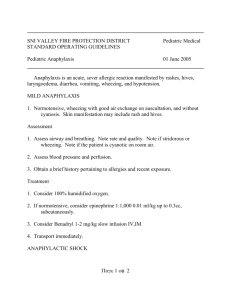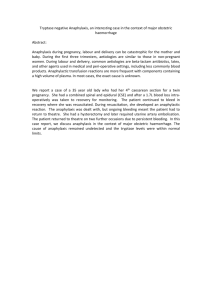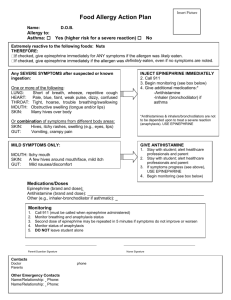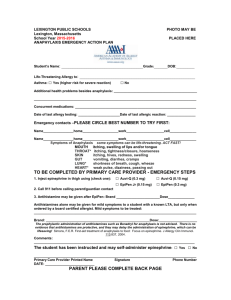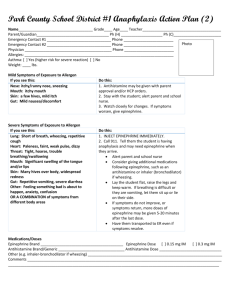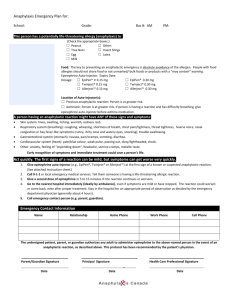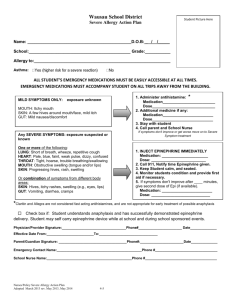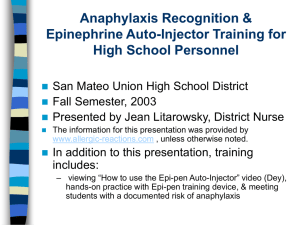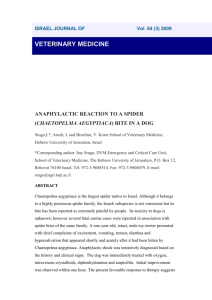General Medical Officer (GMO) Manual: Clinical Section
advertisement
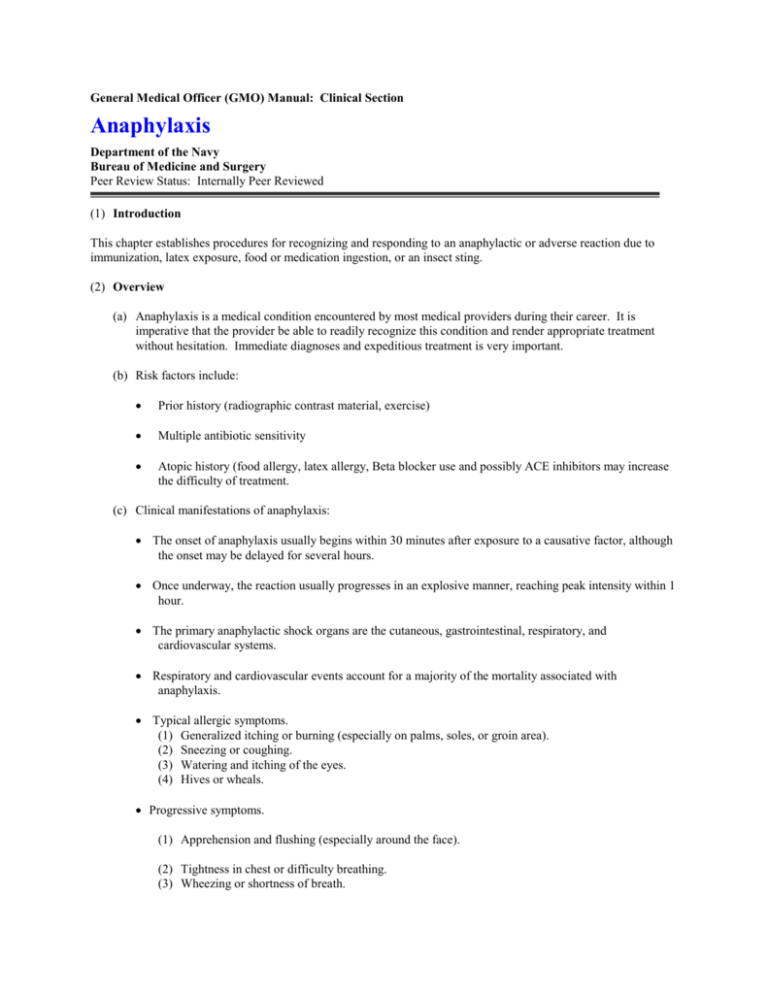
General Medical Officer (GMO) Manual: Clinical Section Anaphylaxis Department of the Navy Bureau of Medicine and Surgery Peer Review Status: Internally Peer Reviewed (1) Introduction This chapter establishes procedures for recognizing and responding to an anaphylactic or adverse reaction due to immunization, latex exposure, food or medication ingestion, or an insect sting. (2) Overview (a) Anaphylaxis is a medical condition encountered by most medical providers during their career. It is imperative that the provider be able to readily recognize this condition and render appropriate treatment without hesitation. Immediate diagnoses and expeditious treatment is very important. (b) Risk factors include: Prior history (radiographic contrast material, exercise) Multiple antibiotic sensitivity Atopic history (food allergy, latex allergy, Beta blocker use and possibly ACE inhibitors may increase the difficulty of treatment. (c) Clinical manifestations of anaphylaxis: The onset of anaphylaxis usually begins within 30 minutes after exposure to a causative factor, although the onset may be delayed for several hours. Once underway, the reaction usually progresses in an explosive manner, reaching peak intensity within 1 hour. The primary anaphylactic shock organs are the cutaneous, gastrointestinal, respiratory, and cardiovascular systems. Respiratory and cardiovascular events account for a majority of the mortality associated with anaphylaxis. Typical allergic symptoms. (1) Generalized itching or burning (especially on palms, soles, or groin area). (2) Sneezing or coughing. (3) Watering and itching of the eyes. (4) Hives or wheals. Progressive symptoms. (1) Apprehension and flushing (especially around the face). (2) Tightness in chest or difficulty breathing. (3) Wheezing or shortness of breath. (4) Rapid, weak pulse. Low blood pressure. Shock. (5) Cyanosis. (d) At the first sign of an anaphylactic reaction, obtain vital signs and the anaphylaxis treatment kit or Advanced Cardiac Life Support (ACLS) cart. If the patient has progressive or severe symptoms such as diffuse hives, wheezing, airway obstruction, hypotension (systolic BP less than 90), or shock, use protocol (3) immediately. (3) Protocol Procedures (a) Assess rapidly. Alert emergency personnel. (b) Place patient in a recumbent or trendelenburg position. (c) Place a tourniquet above injection/sting site(s) to delay absorption of the antigen. Release the tourniquet for 1 to 2 minutes, every 10 minutes. (d) Establish an airway and provide supplemental oxygen. (e) Inject epinephrine (1:1000) 0.01 ml/kg (max. 0.3 to 0.5 cc) subcutaneously opposite the site of injection every 20 minutes x 3. If asthma or wheezing is present, use 0.5 cc. Some have advocated injection of 0.1 to 0.2 cc of epinephrine into the site of the inoculation or sting. Do not consider this procedure if the allergic response site is on the head, neck, hands, or feet. Prompt recognition of anaphylaxis and use of epinephrine is critical. Epinephrine treatment delay can lead to the risk of fatality. For pediatric patients administer epinephrine according to weight as follows: 10 lbs - 0.05cc 30 lbs - 0.14cc 50 lbs - 0.23cc 15 lbs - 0.07cc 35 lbs - 0.16cc 55 lbs - 0.25cc 20 lbs - 0.09cc 40 lbs - 0.18cc 60 lbs - 0.27cc 25 lbs - 0.11cc 45 lbs - 0.20cc 65 lbs - 0.30cc (f) Continuously monitor vital signs, maintain an open airway, establish intravenous (IV) access, and attach a cardiac monitor. Treat for shock if present. Give IV Ringer’s Lactate: 1 to 2 liters (or 20 ml/kg for children) Give dopamine 2 - 20 g/kg/min, only if there is difficulty in maintaining an adequate blood pressure. [Mix 800 mg in 500 cc D5W to make solution of 1600 g/ml. For a 50 kg patient: 5 g/kg/min = 9.4 microdrops/min, 10 g/kg/min = 19 microdrops/min, 15 g/kg/min = 28 microdrops/min, 20 g/kg/min = 37.5 microdrops/min.] (g) Other recommendations as needed include the following: Give Diphenhydramine (Benadryl), 1.25 mg/kg (max. 50 mg) IV over 3 to 5 minutes. THIS IS NOT A SUBSTITUTE FOR EPINEPHRINE. Give Cimetidine (Tagamet), 5 mg/kg (maximum 300 mg) IV over 3 to 5 minutes. Give Aminophyline, 5 mg/kg IV over 20 minutes. Then give 0.5 to 1.0 mg/kg/hr for severe bronchospasm, if blood pressure (BP) and pulse are stable. (h) Glucagon 1 to 2 mg IV bolus, with continuous infusion of 1 to 5 mg per hour if the patient is not responding to epinephrine due to beta-blocker use. (4) Late phase reactions (a) It is important to realize that some patients will resolve their anaphylaxis only to have a spontaneous recurrence 8 to 24 hours later. Bronchodialators prevent the early phase, not the late phase. Corticosteroids may prevent the late, but not the early phase. Cromolyn prevents the early and late phases. (b) Corticosteroids given during the initial phase of anaphylaxis does not prevent the appearance of recurrent or protracted anaphylaxis. Steroids may lessen the chances or decrease the intensity of recurrence, but cannot be relied upon to eliminate this response. However, in severe reactions, it is reasonable to start steroids early to modify or perhaps prevent protracted or recurrent symptoms. The dose for Methylprednisolone is 2 mg/kg, followed by 1 mg/kg every 6 hours. (c) Individuals who have experienced an anaphylactic episode require 12 to 24 hours of observation. (d) All persons with known or suspected anaphylactic episodes require a careful history and clinical evaluation in consultation with Internal Medicine or Allergy. Patients should carry epinephrine and Medic Alert identification. Submitted by CAPT Jay R. Montgomery, MC, USN, MED-22, Surface Warfare Medicine, BUMED, Washington, D.C. (1999). Revised by CAPT J.E. Murnane III, MC, USN, Allergy/Immunology Specialty Leader, Allergy/Immunology Clinic, Naval Medical Center Portsmouth, Portsmouth, VA (1999).
